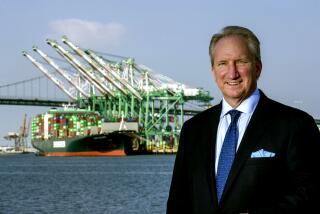‘Nash Bridges’ Set Makes L.A. Scene
A 177-foot barge, once the floating set and soul of the San Francisco-based “Nash Bridges” television show, is almost ready for its close-up. In L.A.
After CBS canceled the long-running Don Johnson and Cheech Marin cop action-drama this summer, two of the show’s executive producers bought the floating set for about a third of its $1.3-million cost and hauled it from Pier 39 in San Francisco to the waterfront of San Pedro.
The producers want to squeeze more life out of the barnacle-bottomed back lot by renting it out for movie shoots, music videos and parties. The barge has been scrubbed and rust has been removed to prepare it for action later this month.
“This is a very unusual, chameleon-like structure. There isn’t anything like it,” said producer Robert Papazian, who joined the “Nash Bridges” show in 1997, along with partner James G. Hirsch, to help rein in the costs of the show, which were more than $2 million an episode.
The ability to recycle the barge long after Nash surrendered his network badge was in the back of Papazian’s and Hirsch’s minds when the floating set was introduced on the show in 1998. Producers paid $175,000 for the vessel--which had been keeping a low profile as a working barge in the Port of Seattle--and then spent more than $1.1 million building a three-story glass and steel structure, which transformed it into a set that could blend into the backdrop of San Francisco.
The structure, an eclectic mix of angles designed by production designer Michael Helmy, was introduced to “Nash Bridges” viewers as a cannery-turned-disco and finally the headquarters for the Police Department’s special-investigations unit.
Now the former make-believe cannery is just a stone’s throw from a real cannery, the soon-to-be-shuttered Chicken of the Sea factory south of the Vincent Thomas Bridge on Terminal Island.
“I’m not aware of any facility like this,” said Steve Dayan, a film-locations manager for 20 years who worked on such movies as “Volcano” and “City of Angels.”
“Any time you have the ability to move a set, that’s really cool,” said Dayan, now a representative of Teamsters Local 399. “I’m sure it will be adapted to meet story needs.”
Papazian and Hirsch said the barge has more than 11,000 square feet of shootable space. They figure it could simulate a houseboat, a factory, an oil rig or even a spaceship. The rooftop could be made to look like an open-air restaurant on the water.
“It’s a set that can be whatever you can imagine it to be,” Hirsch said.
This is not the first time Hirsch and Papazian have turned a hard-edged industrial site into a Hollywood back lot. Four years ago, the pair bought a 189,000-square-foot complex in Canoga Park that had been a Boeing Co. aircraft plant and, more recently, a shampoo factory, which they turned into a studio with six sound stages and post-production facilities.
Now called Ray Art Studios, the campus is being used by Spelling Entertainment for its television series “Charmed” and by Big Ticket Television for its series “Danny,” which will be on CBS Friday nights this fall. “Dr. Laura,” a daytime TV talk show featuring syndicated radio host Laura Schlessinger, also was taped there.
Ray Art Studios employees also will arrange permits and coordinate the shooting schedule for the barge, which Papazian and Hirsch plan to rent to producers for $5,000 to $7,500 a day.
Though Papazian and Hirsch said Friday they’ve already had nibbles from interested producers, some wonder whether the floating set will be viable.
“Companies that shoot in L.A. have a lot of options open to them already,” said Morrie Goldman, vice president for Entertainment Industry Development Corp., the agency that issues permits for filming in most of Los Angeles County.
“They may find much more cost-effective options elsewhere,” Goldman said.
Still, the barge’s new home at the Port of Los Angeles is “a very popular place for filming,” Goldman said.
However, shooting on the water takes a little more planning than packing off to a sound stage, said Chuck Damm, deputy director for the California Coastal Commission.
“It’s an amazing industry. They don’t seem to know that they might need a permit until about two weeks before they want to shoot,” Damm said.
Damm recalled that directors of the movie “Charlie’s Angels” wanted to crash a car off the Vincent Thomas Bridge and were surprised to learn that this would require a state permit.
The “Nash Bridges” barge also might need a permit if it strays much from its current location.
“If they anchor the thing in the Santa Monica Bay, where it raises some questions of possible conflicts with recreationalists, swimmers and surfers, then a permit may well be required,” Damm said. “Definitely if they are going to moor it for any period of time.
“We try to do our best to accommodate,” Damm said. “In fact, I can’t think of one instance where we have ever had to say no.”
More to Read
The complete guide to home viewing
Get Screen Gab for everything about the TV shows and streaming movies everyone’s talking about.
You may occasionally receive promotional content from the Los Angeles Times.







